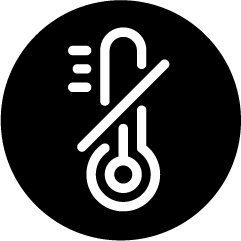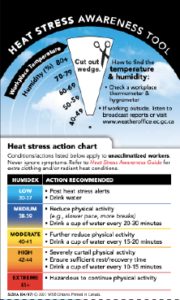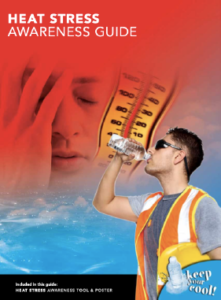NEW HEAT STRESS TOOLKIT – COMING SPRING 2024
Including new calculator, videos, reference guides, infographics and much more!
Including new calculator, videos, reference guides, infographics and much more!
Working in extreme conditions can be hazardous to your health.
Heat and humidex are no exception.
Symptoms of heat stress include:
![]()
Weakness
![]()
Fatigue
![]()
Dizziness
The following Humidex-Based Heat Stress Calculator uses temperature and humidity percentage (%)
to calculate humidex and provides recommended actions.
*NOTE: This works for workplaces where workers are wearing regular work clothes (i.e., no extra clothing or PPE to reduce sweat evaporation rates), and have no significant sources of radiant heat (e.g., sunlight, process heat, etc.). Outdoor workers may have a radiant heat load and thus the use of the calculator for outdoor workers who are not working in the shade, will under-estimate their exposure.
IMPORTANT NOTE:
If you are new to using this calculator please read the Humidex-based Heat Response Plan (Steps) below to learn more about where and how to take measurements, adjusting for clothing and radiant heat, etc.
Next, provide the following information based on the location being measured:
Temperature
Humidity
The humidex level above is colour-coded to correspond with the recommendations below.
HUMIDEX RISK
RECOMMENDED ACTIONS / RECOMMENDATIONS
45+
EXTREME
Only medically supervised work should contine
Humidex exposures above 45, heat stress should be managed as per the ACGIH TLV®
42-44
SEVERE
Work with 45 minutes relief per hour can continue – in addition to the provisions listed below
40-41
SIGNIFICANT
Work with 30 minutes relief per hour can continue – in addition to the provisions listed below
38-39
MODERATE
Work with 15 minutes relief per hour can continue
Note: Worker(s) with symptoms should seek medical attention
34-37
MORE
30-33
SOME
25-29
NONE
General controls apply to unacclimatized workers and include:
![]()
Providing annual heat stress training
![]()
Encouraging adequate fluid replacement

Permitting self-limitation of exposure
![]()
Encouraging watching out for symptoms in co-workers
![]()
Adjusting expectations for workers coming back to work after an absence.
NOTE: clothing and radiant heat must also be taken into account when using this guideline (see steps #1-5 below).
Workers doing moderate work are considered acclimatized in Ontario only if they regularly work around heat sources (e.g. in foundries, around ovens, etc.)
REMEMBER – Never ignore anyone's symptoms – despite what the measurements indicate
A Simplified Method of Protecting Workers from Heat Stress
Based on the 2009 ACGIH Heat Stress Threshold Limit Value® (TLV®), it uses Wet Bulb Globe Temperatures (WBGT) to estimate heat strain.
These WBGT’s are then translated into Humidex.
The ACGIH specifies an Action Limit and a TLV® to prevent workers’ body temperature from exceeding 38°C*
* 38.5°C for acclimatized workers
Below the Action Limit (Humidex 1 for work of moderate physical activity) most workers will not experience heat stress.
Between Humidex 1 and Humidex 2, general heat stress controls are to be provided.
Above Humidex 2, job-specific controls are needed for acclimatized workers.
For unacclimatized workers, job-specific controls may also be needed to reduce heat strain below the TLV® (Humidex 2) criteria.
The TLV® (Humidex 2) only applies to healthy, well-hydrated, acclimatized** workers who are not on medication.
The Humidex plan by itself cannot guarantee that workers will not be affected by heat stress. It is absolutely essential that workers learn to recognize the early signs and symptoms of heat stress and know what to do to prevent them!
If at all possible, workers need to be able to alter their pace of work, rest breaks, and fluid intake in response to early symptoms (240 mL every 20 minutes).
The ideal heat stress response plan would let workers regulate their own pace by "listening to their body" without need for measurements.
Evaporating sweat is the primary way the body gets rid of excess heat build-up, therefore, the best clothing is the kind that makes it easiest for sweat to evaporate. The Humidex plan assumes regular summer clothes (light shirt & pants, underwear and socks and shoes).
For workers who wear cotton overalls on top of summer clothes one should add 5° Humidex (roughly equal to 3°C WBGT) to the workplace Humidex measurement.
For different clothing configurations, estimate correction factor by comparing them with cotton overalls (e.g. gloves, hard hat, apron, protective sleeves might be equivalent to a little less than half the evaporation resistance as overalls so add 1° or 2° Humidex).
If clothes do not allow sweat evaporation (encapsulated suits) heat stress should be managed by monitoring vital signs (see ACGIH TLV®).
Split the workplace into heat stress zones and put a thermal hygrometer in each zone.
Identify a representative location within the zone where measurements can be taken (if you want to base your actions on a single reading, select the highest heat stress zone).
NOTE: The Humidex-based Heat Stress Response Plan is based on workplace measurements not weather station or media reports.
(temperatures inside buildings do not usually correspond with outdoor temperatures)
A thermal hygrometer (usually $10-$50 at hardware or office supply stores) is a simple way to measure the temperature and relative humidity in your workplace.
Once you have the temperature and humidity, use the table above to determine the corresponding Humidex value and the appropriate heat stress prevention response (remember to adjust for clothing (step #2) and radiant heat (step #5)).
Measurements should be recorded at least hourly if the Humidex is above 30° or temperature above 26°.
NEVER IGNORE ANYONE'S SYMPTOMS NO MATTER WHAT THE HUMIDEX!
For outdoor work in direct sunlight between the hours of 10 am and 5 pm, add 2-3º (pro-rate according to percentage cloud cover) to your Humidex measurement.
For indoor radiant heat exposures, use common sense to judge whether the exposure of concern involves more or less radiant heat than direct sunlight and adjust the 2-3º correction factor appropriately.
Vulnerability: There are many permanent or temporary conditions (e.g. age, heart or lung conditions, dehydration, fatigue, some medications, etc.) that can make a person more vulnerable to heat strain. Despite these conditions, workers may be able to cope given adequate knowl-edge of the signs and symptoms of heat stress and, given the latitude to make the appropriate adjustments to their pace of work. It is more often the young, fit workers who may think they are invincible who succumb to heat strain. Some workers may need medical advice about what accommodations would be right for them.
Acclimatization: The MOL heat stress guideline states that "hot spells in Ontario seldom last long enough for workers to acclimatize". Workers performing "moderate" work (e.g. work with some pushing, lifting) would also not be assumed to be acclimatized by the same criteria, unless there is significant radiant heat associated with the work. Workers performing "heavy" work (e.g. shovelling dry sand), however, could probably be considered acclimatized once into the warm weather season. The acclimatized heavy work WBGT numbers are similar to the moderate unacclimatized. Since the TLV® is based on data derived from 20-year-old males weighing an average of 154 lbs., "real" workers probably burn up more calories than the TLV® light category assumes. Selecting the "moderate" work category will account to some extent for workers who are somewhat dehydrated, older (e.g. over 40), not male, and somewhat heavier than 154 lbs.
NOTE: In the translation process, some simplifications and assumptions have been made, therefore, the plan may not be applicable in all circumstances and/or workplaces (follow Step1-5 (above) to ensure the Humidex plan is appropriate for your workplace).
The health effects of heat stress include:
Symptoms: Red bumpy rash with severe itching.
Treatment: Change into dry clothes often and avoid hot environments. Rinse skin with cool water. Wash regularly to keep skin clean and dry.
Symptoms: Sudden fainting after at least two hours of work; cool moist skin; weak pulse.
Treatment: GET MEDICAL ATTENTION. Assess need for CPR. Move to a cool area; loosen clothing; make person lie down; and if the person is conscious, offer sips of cool water. Fainting may also be due to other illnesses.
Symptoms: Heat cramps are painful, involuntary muscle spasms that usually occur during heavy exercise in hot environments. Inadequate fluid intake often contributes to this problem. The spasms may be more intense and more prolonged than typical nocturnal leg cramps. Muscles most often affected include the calves, arms, abdomen, and back – although the cramps may involve any muscle group involved in the exercise.
Treatment: Rest briefly and cool down. Drink water or an electrolyte-containing sports drink. Practice gentle, range-of-motion stretching and gentle massage of the affected muscle group.
Symptoms: Signs and symptoms of heat exhaustion often begin suddenly, sometimes after excessive exercise, perspiration and inadequate fluid intake. Features resemble shock and include: feeling faint, nausea, ashen appearance, rapid heartbeat, low blood pressure, hot, red, dry or sweaty skin, low-grade fever, generally less than 40°C.
Treatment: Get the person out of the sun and into a shady or an air-conditioned location. Lay the person down and elevate the feet slightly. Loosen or remove the individual’s clothing. Have the person drink cold water, not iced, or a sports drink containing electrolytes. Cool the person by spraying him or her with cool water and fanning. Monitor the person carefully. Heat exhaustion can quickly become heatstroke.
If fever — especially greater than 40°C — fainting, confusion or seizures occur, CALL FOR EMERGENCY MEDICAL ASSISTANCE.
Symptoms: The main sign of heatstroke is a markedly elevated temperature — generally greater than 40°C — with hot, dry skin and changes in mental status ranging from personality changes to confusion and coma. Other signs may include: rapid heartbeat, rapid and shallow breathing, elevated or lowered blood pressure, cessation of sweating, irritability, confusion or unconsciousness, fainting, which can be the first sign in older adults.
Treatment: Move the person out of the sun and into a shady or an air-conditioned space. Dial 911 or CALL FOR EMERGENCY MEDICAL ASSISTANCE. Cool the person by covering him or her with damp sheets or by spraying with cool water. Direct air onto the person with a fan or newspaper.
*(EMERGENCY) MEDICAL ASSISTANCE REQUIRED
The items regarding heat cramps, heat exhaustion, and heat stroke are copyright Mayo Foundation for Medical Education and Research.
All Rights reserved. Used with permission from www.mayoclinic.org.
Heat Rash and Fainting adapted from Ontario Ministry of Labour Heat Stress Guideline
(accessed January 2021).
For printing purposes, you can also download the Humidex-based Heat Response Plan as a PDF.
Don’t have access to this online tool while on the job site?
Download this handy Heat Stress Awareness Tool

For additional guidance including extra clothing and/or radiant heat conditions, download this Heat Stress Awareness Guide
